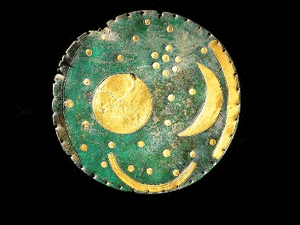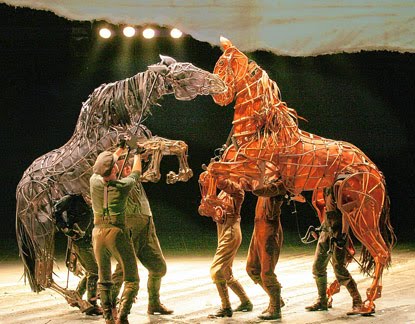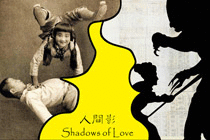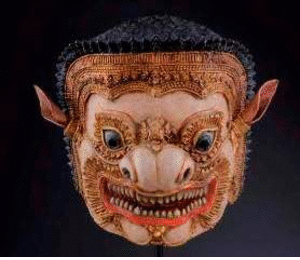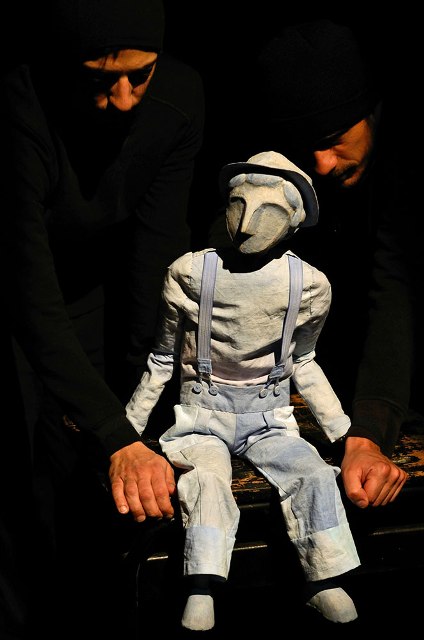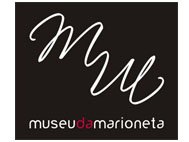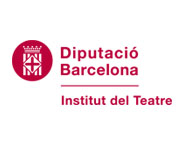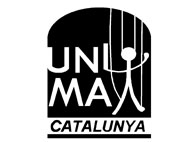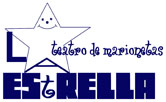At the beginning of October 2013, in the German town of Halle, an unusual opera was premiered that is of particular interest from the point of view of visual theatre and the theatre of objects: its point of departure is the so called Nebra Sky-disc, or, in German, Die Himmelsscheibe von Nebra. A bronze disc, decorated with inlaid gold objects, which represents the sky with the full moon -or the sun, perhaps- and a crescent moon, a number of stars (32 to be exact) and, in the lower section, a sunboat. The Nebra Sky-disc has been a fundamental find for archeologists, given that it is not only the earliest celestial map discovered in Europe – and the clearest from ancient times – but it also explains perfectly the astronomical knowledge people had in the period, and the use to which the disc was put: basically to align the lunar and solar calendars, very important for agriculture, and to keep track of the Winter and Summer solstices.

Poster outside Halle Opera House.
An opera whose central ‘character’ is an object? A sky-disc from the Bronze Age, the jewel of Halle’s Prehistory Museum, taken as the source of inspiration for an opera project? That was the idea and starting point for the librettist Rebecca Simpson, a British writer resident in Barcelona for a good number of years, (she has written other librettos, including Juana with music by Enric Palomar – also premiered by Oper Halle and, in Barcelona, at the Romea Theatre, in 2005), who found herself fascinated one day by the object. Why not write an oratorio about it?, the author asked herself. Have the object speak: a sky-disc is like a mirror which reflects the macrocosmos of the visible universe, with all its mysteries and questions and, simultaneously, like a mirror which focuses on the microcosmos of life on the planet, life at the time the object was in use, but also all that surrounds it, crossing space and time in History. A small disc of about thirty centimetres in diameter suddenly converted into a mirror of the kind that won’t stop talking, and which allows us to focus on Time with a capital T – that of Cosmology, of Science and Quantum Physics – and time, in lower case, of the daily lives of human beings. A disc which talks to us of our Planet as it travels through the centuries, offering rare visions of extraordinary profundiity. A knot, in sum, in which epochs, perceptions, cosmovisions and a flood of questions which still remain unanswered, intersect.

The Nebra Sky-disc. Photo by Franz St. a Flikr.
This was the challenge, and the great achievement, of Simpson’s proposal: to steer opera away from its habitual contents based on feelings and the explosion of human emotions, and to locate it in a new zone in which emotions derive from the excitement of Knowledge, and are associated with cosmological questions and scientific and philosophical queries. Suddenly, opera as an art form, bogged down in psychological dramas and human emotions, jumps to a different register and finds itself on an unusual creative platform, where conflicts are the oppositions and terrible paradoxes related to the adventure of knowledge and understanding. The big, perennial themes – Life, Death, Destiny, Humanity, the Planet, the Past and Future – treated from a distinct point of view, far from the psychological insistence on human emotions. Is this possible? It was a challenge which Simpson set herself, and for which she needed the complicity of a composer capable of understanding these new dimensions of operatic contents.

Rebecca Simpson and Ramon Humet, in Halle Opera.
Ramon Humet, a young Catalan composer whose career is already well stocked with prizes and awards, has been the companion on this adventure. The two artists, it would seem, understood each other from the start. Humet’s highly detailed music, carefully constructed and directed towards a cosmological vision of life, which values subtlety of perception but has no problems rising to explosive heights of intensity, was a perfect match for the aims of the project. An oratorio in which, rather than God, the subject would be the sky, the firmament, the stars, the Cosmos, History and Planet Earth. Thus Oper Halle was approached, (Halle is the same town which houses the precious object, and is therefore sensitive to everything which has to do with the Nebra Sky-disc), and the directors said yes, but on one condition: besides the oratorio, the work must be an opera. That is to say, it must have characters and a story that would justify its place in an opera house.

Photo © Uwe Köhn. Halle Opera.
A new challenge which the librettist Simpson resolved with the idea of a double register or levels for both stage and music: on one hand the oratorio, whose choral music would provide the work’s overall sound world, and, on the other, the stage action comprising a number of characters from the Bronze Age period in which the Sky-disc was made and used. The oratorio sections would focus on the poetic, cosmological and conceptual aspects of the Disc, in terms of a “mirror of the sky and earth”, and the opera parts would deal with the human aspects of the characters, centering on the figure of a smith who has the job of adding certain gold objects to the disc. Two levels which, in a certain way, are in opposition to one another -one based on the the emotions pertaining to knowledge, the other on the human and psychological conflicts of characters facing their destiny. And, in the middle of these two registers, the Sky-disc, the supreme protagonist of the work.

Sandra Maxheimer (Guueren) and Chorus. Foto © Uwe Köhn. Halle Opera.
The results, seen at the premiere in Halle, are highly satisfactory. The stage director, G.H. Seebach, seems to have understood the proposal perfectly in situating the opening of the opera-oratorio in a museum. An appropriate atmosphere for a work concerned with History and Knowledge: the visitors to the museum suddenly become the characters of the period (the Bronze Age) or members of the choir that sing the oratorio. From this moment on, and supported by the stage machinery of a large metal object in the form of a funnel which can open and shut, and is illuminated in different colours, – the lighting is phenomenal -, the action alternates between the oratorio and the unfolding of the Bronze Age story. And let me say here, the work of the singers, committed in body and soul to the work, is extraordinary. Impeccable, also, the work of the musical director, Andreas Henning.

Photo © Uwe Köhn. Halle Opera.
I must mention at this point the authors’ enormous task of musical and poetic craftsmanship that has resulted in a high-level artistic conjunction in which the contents fit like a glove on the rhythmic and musical forms. The text is a display of virtuoso point work and linguistic synthesis, and of the ability to create images of enormous poetic impact, indispensable elements for the treatment of such elevated themes. As regards the music, it escapes easy classification since it uses musical language according to the expressive needs of the text and of the volcanic force which seems to drive Humet’s music. A force nevertheless capable of weaving itself into the most sophisticated and exquisite subtleties of vocal and orchestral sound. The desire to combine form and content led the composer to create a harmony constructed from 32 chords of seven notes each, which evoke the 32 stars encrusted on the Disc that include the constellation of the Pleiades composed of 7 stars.

Gerd Vogel (Fierket) and Robert Sellier (Pyrpi). Photo © Uwe Köhn. Halle Opera.
The movement and play between the two levels -the poetic oratorio of conceptual emotions and the drama of conflicts on a human scale- hang together perfectly in an extremely successful continuum of overlapping endings and beginnings, linked together without interruption. As far as the music specifically of the oratorio is concerned, it fully satisfies the need to express the Sky-disc’s poetic, historical and conceptual charge.

Chorus. Photo © Uwe Köhn. Halle Opera.
Incidentally, three different languages are used in the opera-oratorio: English, German and Catalan. While in the Bronze Age scenes the three languages are mixed, depending on the origins of the characters, the oratorio is basically sung in English, except for certain fragments of text in German or Catalan. A decision which is evidence of a desire to situate the opera in the midst of European thought, and which corresponds to the origin of its creators – Britain, Catalonia and Germany.

Hiltrud Kuhlmann (Tamar), behind: Sandra Maxheimer (Guueren). Photo © Uwe Köhn. Halle Opera.
The question of object theatre, mentioned at the beginning of this article, primarily refers to the Sky-disc, which is constantly present on stage in this production. But more than a theatrical playing with the object itself, what is important here is to underline how the opera in its entirety has emerged from, and rests on, this precious object. A disc that is capable of generating images, reflection, questions, characters from different eras, and which has, essentially, had two uses in its life: to orient those who worked in agriculture in the Bronze Age, in order to organise themselves with respect to the calendar, and to orient today’s researchers about certain realities and historical aspects of our species. A whole complex of uses, nuances and reflections which the undertaking of Simpson-Humet-Seebach distills, with varying degrees of intensity, in this opera-oratorio.
An opera, without doubt, that dared to take risks and has flown high, and which can be added to other works today that attempt to open new roads for opera and music theatre.
Artistic credits:
– premiere: 2nd October 2013, Oper Halle
– musical director: Andreas Henning,
– stage director: G.H. Seebach,
– costumes: Ragna Heiny,
– director of the choir: Jens Pete Montar,
– set design: Hartmut Schörghofer,
– lights: Matthias Hönig
– dramaturge: André Meyer,
– video: Anke Tornow.
– Soloists: Gerd Vogel (Fierket), Sandra Maxheimer (Guueren), Maria Petrašovská (Estria), Robert Sellier (Pyrpi), Hiltrud Kuhlmann (Tamar), Ulrich Burdack (Boatman), Ki-Hyun Park (Priest), Julia Preußler (boy soprano) and Kaori Sekigawa (solo soprano).
– http://buehnen-halle.de/oper/
– http://www.lda-lsa.de/en/
– http://en.wikipedia.org/wiki/Nebra_sky_disk
Final note: the reader shouldn’t imagine that it is all plain sailing in Germany. The incredible quality of the musicians and singers at the Halle Opera House is, also, currently under threat from cuts that hang over the theatre. There is much concern, and protests are constant. By way of example, see the photo of the main entrance of Oper Halle, where an expression of the struggle of members of the theatre can be clearly seen.


